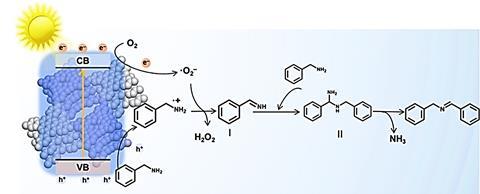
Pyrene-based covalent organic frameworks and blue light can be used to make imines in an environmentally friendly way, Ghent researchers write in ChemCatChem.
Producing useful molecules in a sustainable way is high on the priority list of many chemists. That is why Linyang Wang, Pascal Van Der Voort and colleagues at Ghent University set out to find photocatalysts that use light to couple amines to imines, structures that are widely used in the pharmaceutical industry because of their reactivity and antibacterial effects. They chose a pyrene base and created three different versions of what are known as COFs.
Metal-organic frameworks (MOFs) are well known to most readers of C2W | Mens & Molecule, but less well known are the covalent organic frameworks (COFs) created by the Ghent team. A COF consists of organic molecules that are covalently linked to form a kind of chicken wire. You can then stack this network to form a porous 3D structure. It is very similar to MOFs, but without the metal.
In this case, the best of the three COF variants was one with a combination of pyrene and porphyrin [5,10,15,20-tetrakis(4-aminophenyl)porphyrin]. Pyrene is naturally a good electron donor, while porphyrin is a good electron acceptor. So it makes a good donor-acceptor combination that can properly distribute the electrons from light.
The resulting Py-Por-COF then very efficiently converts benzylamine into N-benzylidene benzylamine under almost ridiculously simple reaction conditions: room temperature, air atmosphere, blue light for one hour, resulting in a yield of 99% with a photocatalytic activity of 20 mmol per gram per hour, one of the highest values ever reported.
The researchers also converted other amines in this way, with yields of ninety per cent or more. They also investigated the recyclability of Py-Por-COF. After four rounds of reactions, the activity and efficiency of the COF remained above ninety percent, making it highly recyclable.

Wang, L. et al. (2024) ChemCatChem e202400200, DOI: 10.1002/cctc.202400200












Nog geen opmerkingen